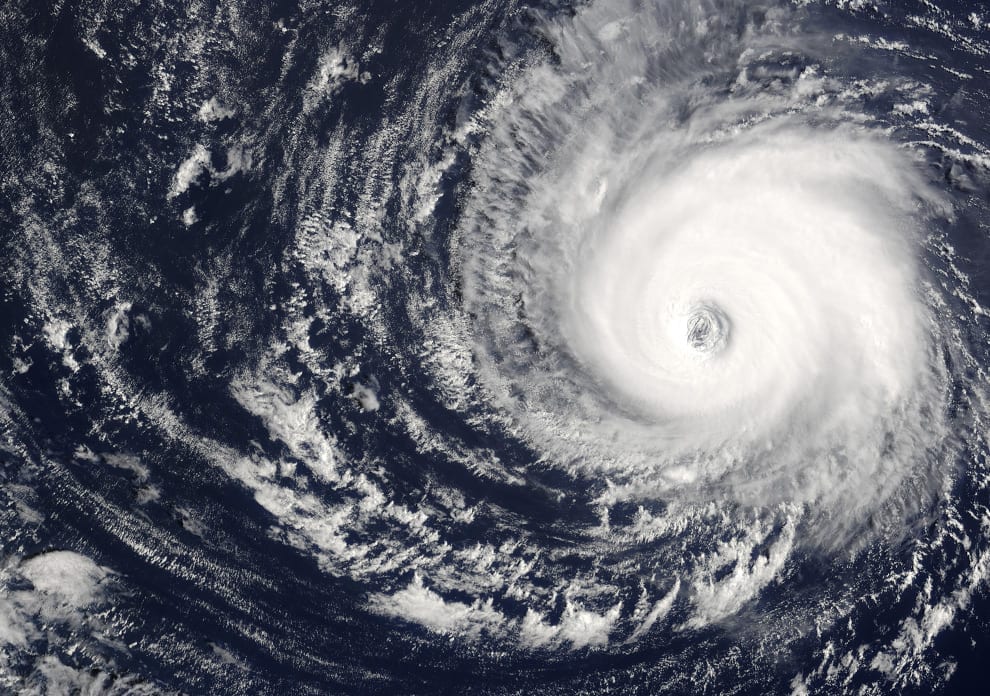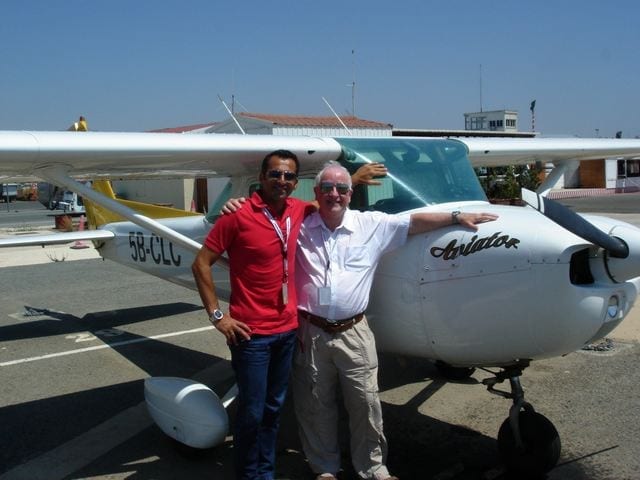When I was a child during the early 60s, we used to spend our summer in Salinas, a small coastal town in Ecuador. The house was very close to runway 26 of a former United States Air Force base, built during the Second World War and by those days already in Ecuadorian Air Force hands, in which operated (and still does) the main basic flight training school in this country. I remember spending the afternoon watching airplanes taking off and landing, but it was not until the late 70s, when in Flying magazine I read an article called “An Invitation to Fly,” that I understood what these airplanes were doing: stalls, touch and go’s, traffic, 360 degree landings, etc.
Then in 1982, when I was 28 years old, El Niño hit my country – all the roads were destroyed. It was an emergency situation and traveling by air was the only option to help people. I was already married with one child when I decided it was time to learn how to fly and eventually to have my own airplane. After two years, I became a private pilot and father of another child. The roads were in good condition and the situation was again normal, so I tried to keep flying just for fun on weekends. But after a while and around 90 hours total time, I had to quit because of family issues.
Time passed, my marriage ended in divorce, the children became adults, I remarried and I almost had forgotten that I had been a pilot for some time in my life. But then, four years ago, Aldo, my aviation course friend, invited me to fly and I was hooked again. I was then 57 years old, so I decided, with my wife’s support, that it was time to give it another chance or forget about it forever.
So here I was in April 2016, now 61 and again a private pilot, this time with an instrument rating, around 380 hours total time and a 2006 Cessna T182T. We were flying to our favorite beach, Salinas, every weekend when an earthquake struck this country on April 16, with catastrophic consequences for the province of Manabi.
On April 19, I received a call from the owner of the FBO where I keep my Cessna. He had organized at the hangar a collection center for food, water, tents and medicine, and was asking for help to transport by airplane the collected goods and doctors to the quake zone, as the roads were badly damaged.
The place to go was San Vicente (SESV), the first time for me – I never had flown there before as a pilot. It is a town right on the coast, 100 nautical miles northwest from Guayaquil (SEGU), my base. Long forgotten by the authorities, the airport almost closed last year, with one worn out asphalt 5000 foot runway, no taxiway, a small terminal building, a tarmac for around four aircraft, and a tower with one person for a couple of flights a week.
The cargo was 350 pounds of goods, to be unloaded at San Vicente, and a passenger from the Ecuadorian Civil Aviation Authority who was going to check the operation at SESV and Manta (SEMT), my second stop, where he would stay.
It is difficult to purchase fuel in this country away from your home base. You have to calculate what you will burn for the round trip before departing, so after calculating fuel and cargo, I filed a VFR flight plan and took off at gross weight, and climbed to 4500 feet with scattered clouds. The response from general aviation had been astonishing and only after changing radio frequency to Guayaquil Informacion de Vuelo, did I realize how many airplanes were going in the same direction.
The normal route to SESV passes by the SEMT terminal area, an international airport, but it had also been very much damaged in the earthquake and after my takeoff I discovered that all the traffic was being diverted to Chone, a town to the east of SESV, as a waypoint to clear the airspace of SEMT, as they were receiving the international humanitarian flights. The problem was that Chone has no airport so I did not have the location in my GPS. Fortunately, I was given radials and distances from other pilots, and could locate it and head in that direction before turning West to SESV.
En route the TAS on board showed many airplanes, and the radio was full of action, but the real surprise was after landing. The tarmac was full of airplanes, at least ten, from 152s to twins, unloading goods. There was only one person dealing with parking, and I saw at least three Army helicopters landing and taking off from nearby platforms. One turboprop arrived after me, and only one person in the tower was dealing with all the traffic. The performance of this man was amazing. Later I learned that his home had been flattened by the quake and he had some members of his own family with injuries. That day, for me, he was a hero.
The weather was hot, the tension from my first landing and the traffic at this airport was high, so after I unloaded the airplane, I started to sweat to the point that I could not file the flight plan to Manta without leaving drops all over the paper. By the time we were ready to depart, there was a Seneca doing the same, so the one man operation tower sent the twin first to the end of the runway followed by me to three-fourths of it. He made me turn 180 degrees and I took off, followed by the twin, and he made us turn in different directions.
I heard later that he also sent two airplanes to different runway ends and made them depart one after the other. In emergency times, these were not by-the-book procedures. No one complained and there were no incidents or accidents, that day or the rest of the week to my knowledge, and the goods and doctors that arrived those few days after the shock were of the utmost importance.
I took off to Manta, and as I turned south and start climbing I saw airplanes and helicopters being held on base, upwind and downwind, waiting to be cleared for landing.
Manta is an international airport which was used by the United States Air Force to fly drug interdiction missions, before the agreement with the Ecuadorian government was canceled in 2007. It has good infrastructure, but the earthquake had destroyed the tower and the terminal building. There was no radar and, as I recall, only one frequency was dealing with approaches and landings, for VFR and IFR.
At the moment I was about to start my VFR descent to Runway 24, I noticed my TAS showing a strange trajectory for an airplane: it was turning from right to left in front of my flight path. I heard over the radio the traffic was starting the procedure turn for an ILS approach, so I realized it was an IFR flight. Fortunately the weather was CAVOK and I could locate and follow this twin turboprop from a world-known courier company, and landed in Manta without any other incident.
By the time I was exiting the runway, my passenger made me notice there was a pickup parked next to the taxiway – inside the truck was Manta ATC. I left my passenger and took off, tired but with the feeling of mission accomplished. The flight back to Guayaquil was uneventful, but it was enough for me and I left to the professionals the flights to SESV for the rest of the week.
The next week I offered myself for another medicine delivery, for a church foundation where my wife works as a volunteer, this time directly to Manta. The conditions had improved a lot with an emergency tower and radar service already operating. Again at gross weight, this time I went IFR and after an easy flight and approach, the medicine was delivered and I returned to my home base feeling proud for what I had done and also feeling great knowing that a very small percentage of people can do what I had just done.
So, 34 years after I had my first thought about flying in an emergency situation, the earthquake made it possible to demonstrate how important general aviation is in this type of situation as first aid. It also showed how important small public airports are, especially when the community needs them.
- Using my Cessna to support earthquake victims in Ecuador - August 11, 2016















Great story!
Thank you, I hope your have enjoyed reading it as much as I enjoyed writing it.
Although I am nearing the end of my flying I admire those that use their talent and resources for humanitarian causes. I commend you for adding to that legacy!
Thank you Mr. Sheetz, I hope you have enjoyed your flying time as much as I am enjoying mine.
Mr. Miraglia, your story is an inspiration. As a pilot who waited until his late 40’s to begin training, I am encouraged to hear the story of another pilot who followed his dream late in life, and inspired by your ambition and spirit of service. Thank you for sharing your story.
Im am glad to see that you are pursuing your dreams, it is never too late.
Vittorio:
It seems that you got your license from Aeroclub del Ecuador, which I was also a member up to 1998. But my membership run-out, because I left the country for 15 years to become a consultant. During which period of time I did very little or no practice at all.
I liked your history because, I would love to get back to flying after 20 years. But the regulations in Ecuador are more papist than the pope.
Any suggestions or recommendations.
NOTE: I presume that the “Aldo” you are referring to is Aldo Borges?
Milton,
Actually it was not that difficult, I just passed the medical with the Civil Aviation Authority and they gave me the license back. Of course I would not dare to fly an airplane then. I had also lost my membership at the club, but they let me take with them the instrument course, which I used to get current again. Today there are several aviation schools in Guayaquil, also in Salinas and I think in Santa Rosa, so there are many choises.
Hope this is useful for you.
Regarding Aldo, yes, his last name is Borges.